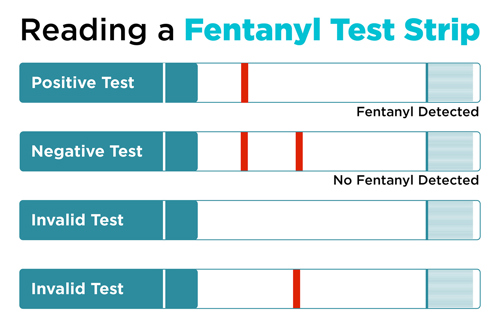How do you use fentanyl test strips?
Not all fentanyl test kits are exactly alike, so always read and follow the manufacturer’s instructions.
The general steps for most test kits are as follows:
- Dissolve some or all of the drugs in water.
- Dip the fentanyl test strip into the water-drug solution.
- Wait as long as specified (usually about 15 seconds) for the test strip to absorb the solution.
- Remove and place the test strip on a flat surface and wait for the time indicated — usually just a few minutes.
- Read the results of the test.
How much do you need to test?
If your drugs are laced with fentanyl, the fentanyl may not be distributed evenly throughout the supply. That’s why experts recommend testing the entire drug supply. The test strips can also be used to test very small samples or even the residue of the supply.
Most tests kits require you to test at least 10 milligrams. Some tests come with a milligram scale or a 10-milligram scoop and require different dilution processes.
The ratio of drugs to water may differ depending on the substance or type of test kit. As a general rule, experts recommend:
- Testing methamphetamine, MDMA, or ecstasy by dissolving 10 milligrams of the drug in 1 teaspoon of water.
- Testing other drugs by dissolving 10 milligrams in half a teaspoon of water.
Remember, fentanyl test strips are not all the same. Use the test kit exactly as directed.
How do you read the test results?
Most fentanyl test strips provide rapid results in the following ways:
- Positive (one red line). YES, fentanyl or a similar synthetic opioid is present.
- Negative (two red lines). NO, fentanyl or a similar synthetic opioid was not detected.
- Invalid (no lines appear, lines are faded, or a single line appears in the wrong place). Perform the test again.

Fentanyl test strips can tell you whether fentanyl is present in a drug supply but not the amount or strength of the fentanyl present. And if you test only a portion of the drugs, you can miss fentanyl in other parts of the supply.
How accurate are fentanyl test strip results?
Fentanyl strips are a reliable way to rapidly detect the presence of fentanyl in illicit drugs. By one estimate, they are 92%–96% effective in detecting fentanyl. The most common reason that fentanyl test strips fail is user error, so be sure to closely follow the test kit instructions.
Because fentanyl tests are not 100% accurate, a negative result does not guarantee that your drug sample is free from all synthetic opioids or other harmful substances. Fentanyl test strips can’t detect certain other synthetic opioids, such as isotonitazene.
In addition, it is possible for one portion of a drug to contain fentanyl while another does not. This is known as the “chocolate chip cookie effect.”
For these reasons, the surest way to avoid an overdose is to not take illicit drugs.